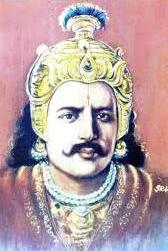 By Srikanta Mohanty: The success scripted on the walls of Elephant Cave is the tale of inspiration that would go down the generations as unforgettable. The lines carved on the walls of the cave in the southern side of Udaya Giri hill near Bhubaneswar about the ‘life and works’ of the emperor, Mahameghavahana king Kharavela, hold everyone captivated in the imagination about the glorious olden days of the pristine statehood of Odisha. The inscription on the walls of cave undoubtedly places the monarch one among the top ten in ancient India.
By Srikanta Mohanty: The success scripted on the walls of Elephant Cave is the tale of inspiration that would go down the generations as unforgettable. The lines carved on the walls of the cave in the southern side of Udaya Giri hill near Bhubaneswar about the ‘life and works’ of the emperor, Mahameghavahana king Kharavela, hold everyone captivated in the imagination about the glorious olden days of the pristine statehood of Odisha. The inscription on the walls of cave undoubtedly places the monarch one among the top ten in ancient India.
Although the emperor lived 2300 years ago, his life-story deserves to become a full-length movie. Born sometime in-between 2nd century BC to 7th Century BC, he became prince of the statehood of Kalinga (Odisha) at the age of 15. His ascension to the throne came at the age of 24.
This was the time, when his state was suffering from the catastrophic defeat from Ashoka- the neighboring king of Magadha. While contemplating strategy for revenge on the neighbor for the humiliation that his state suffered a century before, the king came to know about some disturbing news.
A Greek king had stepped inside India and his armies were advancing towards the state Maghada. Instead of feeling overjoyed at the prospect of his enemy getting taught a lesson by a foreigner, the noble king decided to attack the Greek king. As he acted, the invader was defeated and made to run away with his soldiers.
 The inscriptions in the Elephant Cave (Hathi Gumpha) list out the illustrious king’s achievement during his reign. As the scion of Mahameghabhana dynasty, his successive conquests to the state of Magadha resulting in bringing back all the glories and riches that as a state, Kalinga, had lost in the war with emperor Ashoka.
The inscriptions in the Elephant Cave (Hathi Gumpha) list out the illustrious king’s achievement during his reign. As the scion of Mahameghabhana dynasty, his successive conquests to the state of Magadha resulting in bringing back all the glories and riches that as a state, Kalinga, had lost in the war with emperor Ashoka.
Kharavela was equally successful in his military campaigns against the Tamil states and defeated all of them. He expanded his monarchy towards north, south, and west conquering vast stretches of land all-over the nation.
“As a good ruler, he had implemented great schemes both for rural and urban population in the state. He has been accorded the highest status in the precepts of history not only for his successful invasion of states but for his highest contribution to the welfare of subjects in his state.
Nowhere during his regime, he displayed the ruthlessness that different invaders showed during the military expeditions. He built up his capital, Kalinga Nagari, in such remarkable way that it stayed etched in golden letters on the pages of history for good”-says Padmanabha Mishra- a retired faculty member in History from Utkal University and avid collector of facts of the Emperor’s life.
